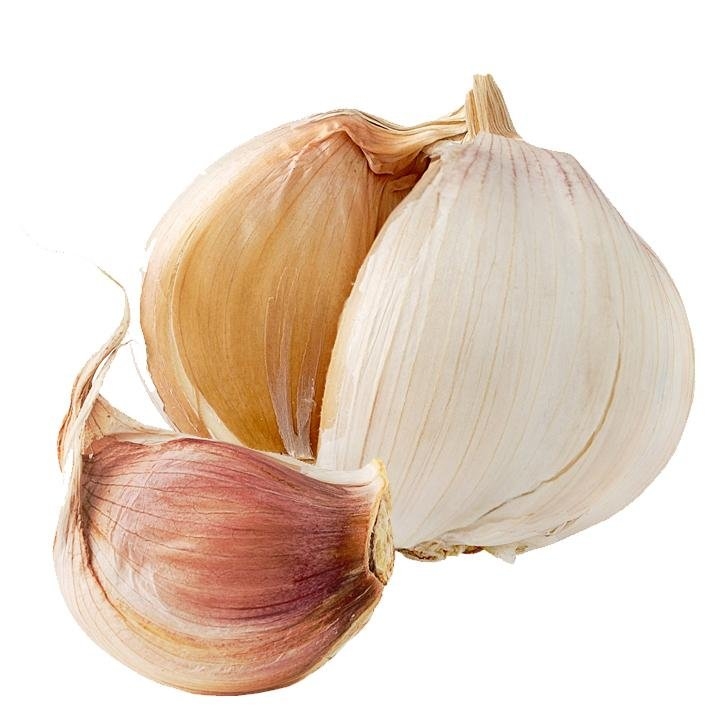Description
Herbaceous, perennial, vivaceous and bulbous plant, up to 50 cm high. It grows from a bulb from which photosynthetic leaves and inflorescence arise. The so-called bulb or head of garlic is a compound bulb, subglobular, 3-5 cm wide formed by a group of simpler bulbs: the main stem of the plant is very short and produces leaves merged by their edges forming tunics. The leaves that emerge from the main stem are not fleshy but thin, and papery when dry. In the axil of these tunics, buds are formed, each of those is transformed in a small bulb (the garlic clove). Cloves are ovoidal and show 3-4 sides of shaped apex and truncate base.
The leaves of the plant are cylindrical, flat and thin, up to 30 cm long. They show a tunicate base that forms a sheath and sessile limb, acintated, with parallel margins. Flowers are small, trimerous with pink and white perigone, 6 stamens and tricarpellate gynoecium that fructifies in capsule. However, in the case of garlic few flowers are formed at inflorescence and the most part are sterile. The rest is transformed in small bulbs, very similar to those formed in the bulb. Monocotyledonous plant, Liliflora order, Liliaceae family, Allioideae subfamily, Allium genre, Sativum L. species
Plant indigenous to middle Asia, from where it passed to Egypt, Greece, Rome, and the rest of Europe. It was brought to South America by the Spaniards. Although its origin is not well known, its domestic use probably started somewhere in Central Asia from some unknown wild species. The wild species closest to garlic seems to be Allium Longicuspis Regel. of Central Asia.
There are many varieties of garlic, being the most common the white garlic. There are pink, purple, great-headed and small garlic. It is a species very cultivated in temperate areas all around the world. Garlic is a cultigen or a plant that is only found when cultivated (it depends on humans to its propagation). The environmental requirements for its propagation are soils with good drainage, preferably loamy or clayey soils, rich in organic matter and moisture, with temperatures under 17 ºC. Planting is recommended during winter or early spring, when the clove has already sprouted and the new stem reaches 50% of the length of the clove. The garlic blooms between the end of spring and the beginning of summer. The optimal moment for harvesting depends on the subsequent use of bulbs. If the goal is to obtain seeds for a later seeding, then the harvesting has to be carried out when the leaves starts to shrivel. On the contrary, if the plant will be used for consumption, the harvesting will be carried out when the leaves are completely dry. The complete cycle, from germination to harvesting of the new bulbs takes at least eight months. A particular characteristic of the bulb is the strong odor that it gives off when cut.
Part used
The bulbs.
Indications
Internal use:
- Prevention and treatment of atherosclerosis.
- Hyperlipidemias: Hypercholesterolemia and hypertriglyceridemia.
- High blood pressure.
- Thromboembolism prevention.
- Intermittent claudication.
- Retinopathies.
- Ventricular and supraventricular arrhythmia.
- Intestinal parasites: ascaridiasis, oxyurasis, giardiasis, lambliasis.
- Intestinal infections: amoebic and bacterial dysentery.
- Adjuvant treatement for diabetes.
- Respiratory diseases: flu, pharyngitis, tracheitis, sinusitis, bronchitis, emphysema and asthma.
- Genitourinary diseases (apart from the diuretic effect of frutans, allicin and its derivatives are excreted basically by the kidney): cystitis, urethritis, pyelonephritis, urolithiasis.
- Rheumatisms, hyperuricemia.
- Prevention of stomach, esophagus and colon cancers.
External use:
- Skin diseases: athlete's foot, wounds, etc.
- Insect bites.
- Warts, corns, calluses.
- Ear pain, otitis. It is not recommended to use garlic in the treatment of inner ear infections, especially in children as it may produce strong irritation.
- Arthritis and arthralgias, neuralgias (sciatic).
- Vaginal candidiasis, thrush, and periodontal disease.
Bibliography
Real Farmacopea Española. 2ª Edición 2002.
The Complete German Commission E Monographs.Therapeutic Guide to Herbal Medicines. Blumenthal. Busse, Goldberg, Gruenwald, Hall, etc.
Botanical Influences on Illness. A sourcebook of clinical research. Melvyn R. Werbach, M.D. & Michael T. Murray, N.D. Third Line Press.
Jean Bruneton. Farmacognosia. Fitoquímica Plantas Medicinales. 2ª Edición. 2001. Ed Acribia. S.A.
Plantas Medicinales y Drogas Vegetales para infusión y tisana. Edición Española a cargo de: Salvador Cañigueral, Roser Vila, Max Wichtl. 1998.
Fitoterapia aplicada. J.B. Peris; G. Stübing; B. Vanaclocha. 1ª Edición. Colegio Oficial de Farmacéuticos de Valencia.
Elementos de Fitoquímica y de Farmacognósia. Jean Bruneton. Ed Acribia. S.A.
Pharmacognosy, Phytochemistry, Medicinal Plants. Jean Bruneton. Lavoisier Publishing.
Fitoterapía. Vademecum de Prescripción. Plantas Medicinales. Aasociación Española de Médicos Naturistas. Colegio Oficial de Farmacéuticos de Vizcaya.
